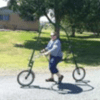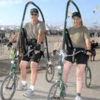Introduction
GlideCycle™, an Oregon based company, has created an entirely new frontier in human mobility and exercise that simply did not exist before the revolutionary GlideCycle PT™.
This mobility device, originally designed as a low-impact trainer, is producing incredible changes in people’s lives that were never imagined or expected.
- People who never expected to run again are running and are able to enjoy significant aerobic training benefits in spite of permanent disabilities, painful joints, injuries, various neurological conditions and challenges associated with excess body weight or obesity.
- Individuals with physical disabilities, such as amputees, have experienced the freedom to run long distances, upright and standing, with friends, family and children while enjoying the outdoors. The GlideCycle helps many accommodate and overcome physical barriers to effective and enjoyable exercise.
- Athletes have been able to safely and effectively train through injures with faster recoveries and return to sports.
- Aging baby boomers and many others, have a fun and optimal form of low-impact exercise.
Benefits for Individuals with Physical Impairments
While cardio-respiratory fitness was our original goal, we have discovered additional rehabilitative benefits of regular GlideCycle™ training in widely different patient populations, including those with physical disabilities. Data collected on amputee GlideCyclists training 2-3 times per week, signed off by each individual’s physician, have shown exciting benefits:
- Significant increases in the ability to tolerate and ambulate in prosthetic devices for longer periods of time, leading to three local amputees no longer relying on wheelchairs as a primary form of mobility, even after years of wheelchair confinement.
- Greatly improved balance, fall resistance and recovery, as well as ambulatory capacity.
- Considerable weight loss: Over 50 pounds in one above-knee amputee, 42 pounds in a second above knee amputee, 12 pounds in a new below-knee amputee exerciser, and five pounds in an already thin below knee amputee.
- Significant reduction or elimination of pain and antidepressant medications, including reductions in phantom leg and sciatic-type nerve pain.
- Increased strength, endurance and upright posture.
- Improved overall sense of well-being, confidence and levels of motivation.
- Independence in mobility, function, and ability to take charge of physical and psychological health for the first time in years.
Such benefits are above and beyond what most rehabilitation programs are able to offer within a limited available treatment time and number of visits.
Applications for the GlideCycle™
Based on our observations and experiences, GlideCycle™ use may have exciting applications for individuals with the following or similar conditions:
- Amputations
- Sports and training injuries
- Joint and orthopedic injuries (including pre and post-operative)
- Obesity
- Impaired balance and de-conditioning in geriatric clients
- Depression
- Chronic pain syndromes
- Incomplete spinal cord injuries
- Other neurological injuries suffered from trauma
- CVA
- Neurological diseases (MS, Parkinson’s, etc…)
- Post-Polio Syndrome
- Diabetes, peripheral neuropathy or other associated circulatory disorders
- Traumatic brain injuries
- Heart disease
- COPD and other respiratory conditions
- Substance abuse issues
GlideCycle™ Comparison to Other Forms of Exercise
Challenges: It is important to realize that many disabled individuals, such as amputees of various levels, encounter unique challenges that limit exercise options. Bicycling is simply not an option for a majority of amputees due to level of amputation, difficulty of maintaining feet comfortably on the pedals and the level of balance required to stay upright and safe. With higher amputations, performing a pedal stroke becomes difficult due to missing muscle groups as well as potential shearing forces that can occur where the skin meets the socket.
Uniqueness: A unique feature of the GlideCycle™ that does not occur with bicycling is simulation of normal walking and running motions that lead to improved functional abilities, ambulatory capacity, balance, fall recovery and resistance.
Challenges: Only few, select athletes with access to the most sophisticated and expensive prosthetic technology will ever experience the ability to tolerate running for exercise. Walking long distances or rapidly in a prosthetic limb is quite uncomfortable and not possible for many amputees. Also, upper body ergometers and hand cycles do not translate to improved function in large muscle groups used for ambulation and are not tolerated well by many individuals with shoulder or arm ailments, weakness or sensitivity to cardiorespiratory stresses.
Benefits: The GlideCycle™ simply allows a fun outdoor workout vs. confinement to indoor, stationary exercise machines. Thus, our GlideCycle™ users have been motivated to exercise for longer periods of time than on other exercise equipment.
GlideCycle™ as a Mobility Device
GlideCycles™ may be utilized as mobility devices (an in-line wheelchair) for those with injuries or physical disabilities to cover large distances at stores, sporting events, malls or parks as demonstrated by members of our “Amputeam”. GlideCycles may also be used for on the job mobility, or transportation to and from jobs.
Support from Veteran’s Administration
The Palo Alto, Monterrey, Roseburg, and White City Veteran’s Administrations have shown enthusiasm and support for developing GlideCycle™ programs with outcome based testing of psychological as well as physical benefits from regular GlideCycle™ use. We continue to receive requests for GlideCycle™ programs from Veteran’s Administrations, Physical and Recreational Therapy Departments and Adaptive Sports programs across the United States.
Recent GlideCycle™ Developments
We are excited to unveil two new GlideCycle™ products that have been developed in response to frequent requests from medical staff, physical therapists, and patients.
GlideTrak™: Our first new product is the GlideTrak™: An introductory component of the GlideCycle™ system that is readily adaptable to any treadmill system. The GlideTrak™ may be utilized in therapy departments, athletic training centers and fitness clubs.
The GlideTrak™ is ideal for:
- Early introduction of normalized gait patterns after injury or surgery, where normally pain, swelling and weakness would cause limping or require the use of an assistive device.
- Post-operative total hip patients to normalize gait and maximize strength and motion, especially hip extension.
- Post-operative total knee patients to normalize gait and maximize strength and motion, especially terminal knee extension.
- Post-operative patients who typically have to wait four or more weeks for incisions to heal before starting pool therapy to improve walking.
- Early and safe introduction to running after injury or surgery.
- Gait training and conditioning for geriatric patients.
- Overweight patients seeking a comfortable mode of conditioning.
- Conditioning for those with painful joints or neurological conditions.
- Facilitation of ambulatory motor patterns in clients with neurological conditions / injury
GlideTrike™: The second new product is the GlideCycle™ “Trike”, a three-wheeled version that allows clients with more significant balance impairments to enjoy GlideCycle™ mobility and training.
Contact us with any questions or comments.






